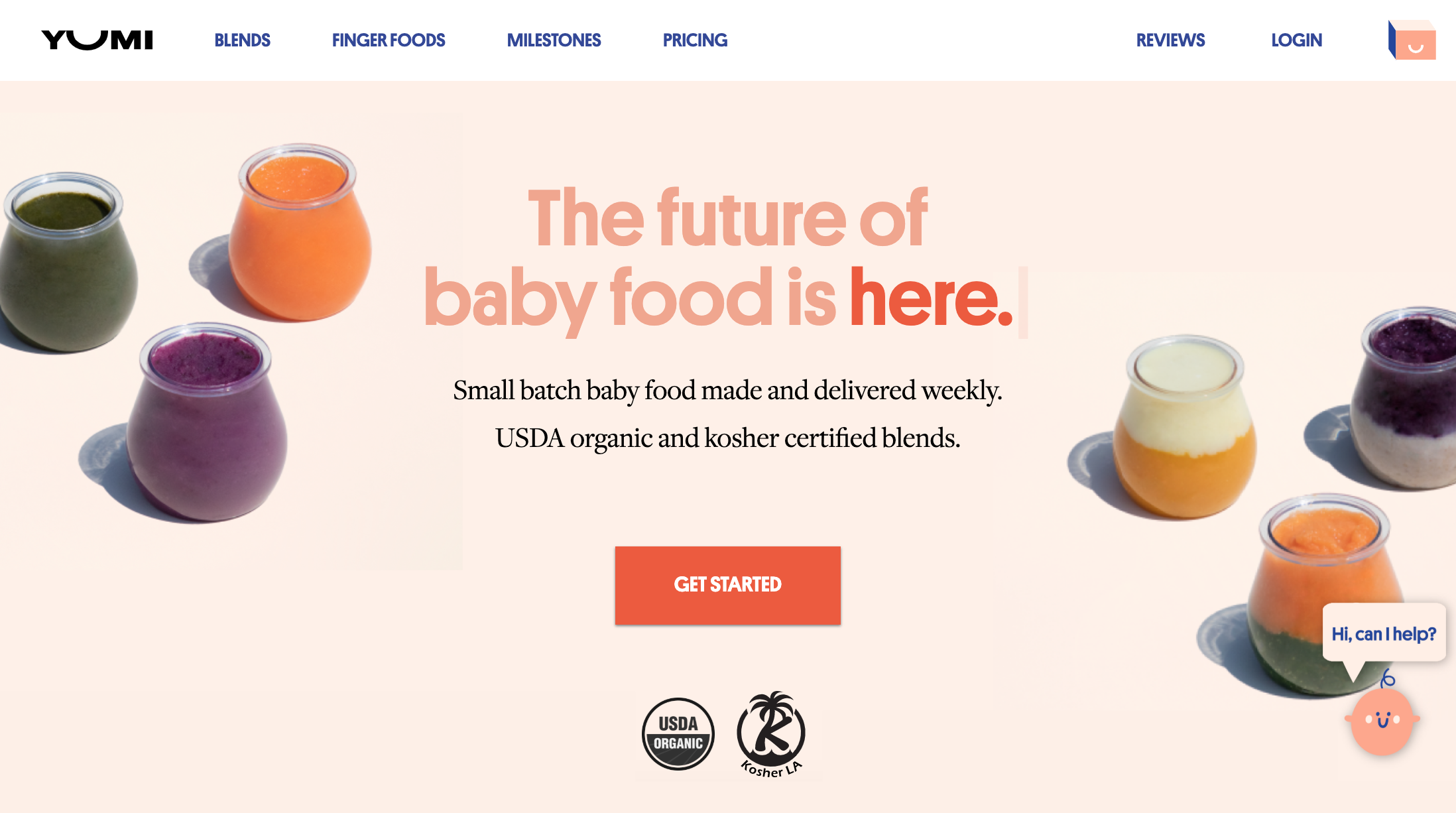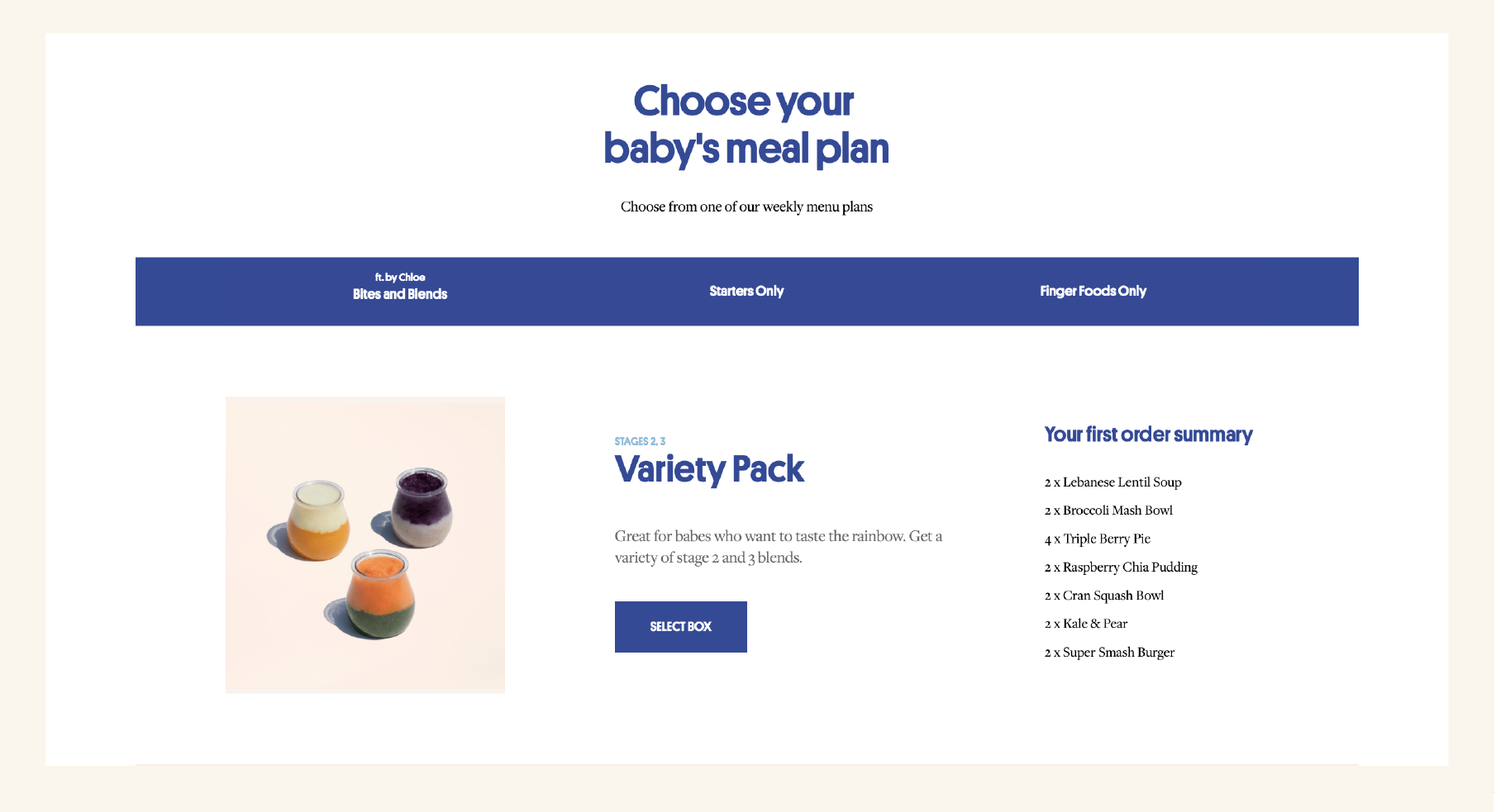How can we balance shipping requirements with our users’ desire for individualized products?
Designing a flow for controlled user customization
Summary
As Yumi’s customer base and food options grow, the company has begun looking for a way to allow users to customize their baby food orders while optimizing the shipping process.
Project Duration
1 week
Team
This project was a solo effort
Contributions
Conceptual design for a new user flow for selecting baby foods based on flavors parents want to give their baby.
Product photography and illustrations provided by Yumi.
Yumi (yoo-me) is a small startup that makes and delivers baby food fresh to your door on a weekly basis. Their baby food is made fresh, organic, and low sugar.
Every blend Yumi produces is backed by scientists and nutritionists to help your baby develop their brains and body during the first 1,000 days of life.
Customers sign up for a subscription based on how many meals they want per day - 1, 2, or 3. They either have Yumi send jars based on their baby's age and developmental needs, or they log in each week and choose their own jars.
To make packing and shipping more efficient, Yumi’s CEO has chosen to implement restrictions on the number of combinations that can be made.
Returning users can now only select jars from 35 preset combinations of groups of 4. New customers have less options and larger packs, which allows them to try a variety of food options.
So how can Yumi make customers feel like they are getting the blends that are customized to their needs while still limiting combinations for efficient shipping?
With such a quick project turnaround, time for research was limited. Reviews on the site itself were great for insight into how people felt about the product and what didn’t work for them.
It became apparent very quickly that many people were throwing food away when their baby didn’t like it, and there weren’t enough options to choose from that included only blends their child would eat.
There is no option for customers to give feedback on particular blends or packs, so how can Yumi know what works their users, picky eaters or not?
The current sign up process is only 4 steps and doesn’t require as much information as some of its competitors. But most parents already know what their baby likes and they don’t necessarily want a random set of foods their baby may or may not enjoy.
Assumption
New Yumi parents don’t know what blends their baby likes. They start by letting Yumi send a variety pack and then choose what they like or don’t like from there.
However, most parents do know what types of food their babies prefer or dislike.
Solution
Parents can set their food preferences for their baby and Yumi will remember this each time they come back. Yumi will recommend more packs with foods they like and less or none with foods they want to avoid.
After delivery, Yumi will ask how baby (and parents) liked each blend in the pack. Answers will be remembered and factored in to the recommendations. As Yumi learns what a customer likes and doesn’t, the recommendations will get better.
For new customers, the sign up process starts the same, with a few visual updates to freshen up the design.
Next, customers choose how many meals they want to feed their baby per day. This allows Yumi to determine how many packs of four need to be ordered per week.
One meal per day delivers 8 jars per week, two delivers 16, and three delivers 24.
The third step in the process is where users are asked to go through a list and select the foods they do and don’t want to see in their recommendations.
Yumi will recommend more foods that are marked with a green check, will show no preference for the grey slash, and will avoid blends that include ingredients marked with a red x. All of these preferences can be changed in the user's profile as their baby’s yums and yucks change.
Returning customers will be brought directly to the Yums and Yucks page on their first visit after implementation, they won’t have to re-select their meal plan or provide additional information.
Finally, Yumi will make an initial recommendation to users based on the yums and yucks entered on the previous page.
The user can either select from the options provided or view and pick from the weekly menu by clicking on the “more options” button.
Once they have selected the proper number of packs, clicking “next” will bring the user to the checkout page where they can complete their order. Here, new users will complete the subscription sign up process as well.
On their next visit following the delivery of their package, users will be prompted to provide a short and sweet review of each of the blends they received.
Not only does this help refine the recommendation process over time, but Yumi can collect valuable information about how their individual blends are received by babies and parents alike.
User preferences are saved in their personal profile and can always be adjusted as their babies grow and tastes change.
Additionally, users can view all blend packs, regardless of the ingredients. However, Yumi will automatically sort the menu based on the evolving Yums and Yucks list.
As Yumi expands their business and begins to offer a larger variety of ingredients and blends, the Yums and Yucks list can be expanded and adjusted to better suit the needs of the users.
By doing this, Yumi can begin to build a database of information that not only benefits the users, but can be used to tell their chefs and production line what blends and ingredients are in demand. This data can be used to help build new menus, introduce new ingredients, and offer more of the products that their customers love most.














